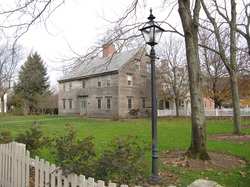
Sunday, November 13, 2011
When I arrived in Lowell, I came equipped with a "to do" list. I am slowly checking it off.. I have prioritized where I would go based on when the site closed for the winter. For example, I visited the Shelburne Museum in Vermont on October 30, the final day of their 2011 season. When I came to Massachusetts, I was surprised to find that many venues are not open year-round like in Missouri. But, if you think about it, it makes perfect sense because of the extreme and prolonged cold during the winter months. Of course, another big consideration in deciding when to go where has been the weather. Thankfully, the fall has been unseasonably warm this year. I have had beautiful weather every weekend. Today it was above 60 degrees and sunny. So, I really had a beautiful day to visit Historic Deerfield. After having visited Sturbridge Village, I thought Deerfield would be similar. I was so wrong! Deerfield is not a recreated historic town. It is an historic town that continues to exist and thrive. It is considered an important site because it is the most well documented historic town in the U.S. A few of the original structures are still standing. The homes that are part of the Historic Deerfield park are interspersed with private homes. It looks like a regular small town with really old homes! Deerfield dates back to about 1670 when settlers chose the site because it was located between two rivers and offered rich farm land. In fact the Indians had been farming there for thousands of years. Deerfield was in the thick of King Phillip's War and Indian raids were a way of life until almost 1850. After all, Deerfield was considered a western frontier -- no kidding!
In the 1940's Henry and Helen Flynt purchased a home in Deerfield and began collecting antique furniture and other decorative arts. Eventually, they established Historic Deerfield. It has several homes open to the public that depict colonial life and early American living. The home that I enjoyed touring the most was the Wells-Thorn House. Within this one house, life in different time periods is depicted. The first room was a great room from 1770. It was where everything happened -- cooking, sleeping, living. As we went from one room to another, the date advanced by 25 to 30 years. It was fascinating to see these transitions. The bedding and bed hangings progressed beautifully! The earliest beds shown had bed hangings, for privacy, no doubt. Often the bed was located in the parlor and was where callers were received. As time went along, of course the quilts and hangings became more elaborate, and were more decorative.
The thing I was most looking forward was going to the Flynt Center. This is a museum dedicated to furniture, textiles, ceramics, and other early American objects such as powder horns. They have a very nice textile gallery. The current exhibit highlights the four natural textile fibers: flax (linen), cotton, silk, and wool. Very beautiful extant garments were on exhibit for each category. Today there were a few quilts on exhibit. These were all beautiful and included palpamore, counterpane, mosaic, and wholecloth quilts as well as a woven coverlet. Darn I wish more were out! But it was still a great visit.
When I arrived in Lowell, I came equipped with a "to do" list. I am slowly checking it off.. I have prioritized where I would go based on when the site closed for the winter. For example, I visited the Shelburne Museum in Vermont on October 30, the final day of their 2011 season. When I came to Massachusetts, I was surprised to find that many venues are not open year-round like in Missouri. But, if you think about it, it makes perfect sense because of the extreme and prolonged cold during the winter months. Of course, another big consideration in deciding when to go where has been the weather. Thankfully, the fall has been unseasonably warm this year. I have had beautiful weather every weekend. Today it was above 60 degrees and sunny. So, I really had a beautiful day to visit Historic Deerfield. After having visited Sturbridge Village, I thought Deerfield would be similar. I was so wrong! Deerfield is not a recreated historic town. It is an historic town that continues to exist and thrive. It is considered an important site because it is the most well documented historic town in the U.S. A few of the original structures are still standing. The homes that are part of the Historic Deerfield park are interspersed with private homes. It looks like a regular small town with really old homes! Deerfield dates back to about 1670 when settlers chose the site because it was located between two rivers and offered rich farm land. In fact the Indians had been farming there for thousands of years. Deerfield was in the thick of King Phillip's War and Indian raids were a way of life until almost 1850. After all, Deerfield was considered a western frontier -- no kidding!
In the 1940's Henry and Helen Flynt purchased a home in Deerfield and began collecting antique furniture and other decorative arts. Eventually, they established Historic Deerfield. It has several homes open to the public that depict colonial life and early American living. The home that I enjoyed touring the most was the Wells-Thorn House. Within this one house, life in different time periods is depicted. The first room was a great room from 1770. It was where everything happened -- cooking, sleeping, living. As we went from one room to another, the date advanced by 25 to 30 years. It was fascinating to see these transitions. The bedding and bed hangings progressed beautifully! The earliest beds shown had bed hangings, for privacy, no doubt. Often the bed was located in the parlor and was where callers were received. As time went along, of course the quilts and hangings became more elaborate, and were more decorative.
The thing I was most looking forward was going to the Flynt Center. This is a museum dedicated to furniture, textiles, ceramics, and other early American objects such as powder horns. They have a very nice textile gallery. The current exhibit highlights the four natural textile fibers: flax (linen), cotton, silk, and wool. Very beautiful extant garments were on exhibit for each category. Today there were a few quilts on exhibit. These were all beautiful and included palpamore, counterpane, mosaic, and wholecloth quilts as well as a woven coverlet. Darn I wish more were out! But it was still a great visit.

 RSS Feed
RSS Feed